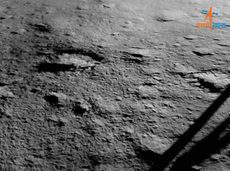India landed on the Moon for less than it cost to make Interstellar
Some houses cost less than Indian space agency spent on getting to the Moon
Your support helps us to tell the story
From reproductive rights to climate change to Big Tech, The Independent is on the ground when the story is developing. Whether it's investigating the financials of Elon Musk's pro-Trump PAC or producing our latest documentary, 'The A Word', which shines a light on the American women fighting for reproductive rights, we know how important it is to parse out the facts from the messaging.
At such a critical moment in US history, we need reporters on the ground. Your donation allows us to keep sending journalists to speak to both sides of the story.
The Independent is trusted by Americans across the entire political spectrum. And unlike many other quality news outlets, we choose not to lock Americans out of our reporting and analysis with paywalls. We believe quality journalism should be available to everyone, paid for by those who can afford it.
Your support makes all the difference.India has successfully landed on the Moon – for less than the cost of the film Interstellar.
The Indian space agency announced on Wednesday that it had completed a “soft landing” on the lunar surface, near its southern pole. It becomes the first ever to land there, and just the fourth country to successfully send a mission to the Moon at all.
And it did so on a very restrictive budget. The Chandrayaan-3 cost was sent to the Moon at a cost of about 6.15 billion rupees, or $75 million, according to Reuters.
That is less than the cost of most blockbuster space films. Gravity cost $100 million, The Martian cost $108 million – and it was less than half the cost of Interstellar, which was filmed on a budget of $165 million.
It even costs less than some houses. The UK’s most expensive house, for instance, went on sale at £200 million, or nearly three-and-a-half missions to the Moon.
The budget is even less than India allocated to Chandrayaan-2, the previous attempt to land on the Moon in 2019, which ended in failure when the lander crashed. That cost around 8 billion rupees, or about 30 per cent more than the latest successful mission, though engineers have made clear that many of the learnings from that earlier launch had been integrated into the latest one.
India has looked to build a reputation for cost-effective but still successful missions to space. It comes as the country encourages investment in the private space industry and businesses focused on satellites.
The price of the whole Indian mission is similar to that charged by SpaceX for one Falcon 9 launch. That is charged at $67 million, according to its website.



